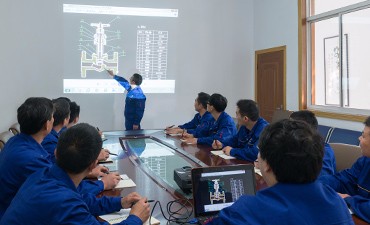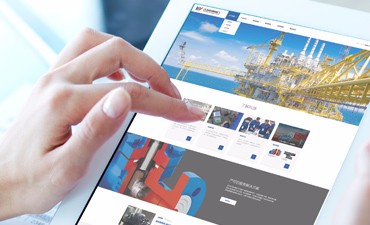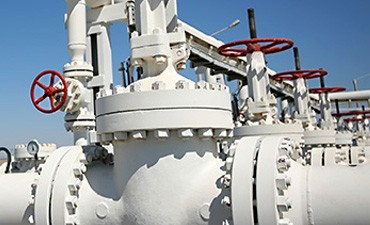Performance and characteristics of various valves
Release time:2018-09-19Browsing volume:893
Regulating valve
Regulating valves play an important role in the automatic control of modern chemical plants. The production of these plants depends on the correct distribution and control of flowing media. These controls, whether energy exchange, pressure reduction or simple container charging, require some final control elements to complete. Common control loop consists of three main parts, the first part is the sensor, it is usually a transmitter. It is a device that can be used to measure the process parameters, such as pressure, liquid level or temperature. The output of the transmitter is sent to the regulator, the regulator, which determines and measures the deviation between the given value or expected value and the actual value of the process parameters, and one by one sends the correction signal to the final control element, the regulator. The valve changes the flow of the fluid and makes the process parameters meet the expected value.
Performance characteristics:
The regulating valve has simple flow path and small resistance, and is usually suitable for forward use (installation). However, in the case of high pressure drop regulator valve reverse use to improve unbalanced force and reduce damage to the spool, but also conducive to the flow of media, to avoid the control valve coking and clogging. Normally, the regulator valve is not recommended for reverse use, only in high pressure difference, high viscosity, easy coking and suspended particulate media is recommended for reverse use. When used in reverse direction, the operation should be avoided under the condition of long opening, especially when testing.
Two. Throttle valve
The shape of the choke valve is not different from that of the globe valve, but the shape of the opening and closing parts is different. The opening and closing parts of the throttle valve are mostly tapered streamline, which can adjust the flow and pressure by changing the cross-section area of the passage. The throttle valve is used for reducing medium pressure in the case of great pressure drop.
Performance characteristics:
1, the structure is relatively simple, easy to manufacture and repair, low cost.
2, the adjustment accuracy is not high, can not be used as a regulator.
3. The sealing surface is easy to be eroded and can not be used as cutting medium.
4, poor sealing.
Three. Pressure reducing valve
The pressure relief valve has a piston or diaphragm structure, and the output pressure acts on the piston or diaphragm to overcome the adjustable spring force to balance. Adjust the secondary pressure with the adjusting screw, set the spring load to open the main valve, let the air flow from the initial pressure P1 input to the secondary pressure P2 output port. When the loop connects the output port to the set pressure, the air in the loop acts on the diaphragm and produces a lift relative to the spring force. If the flow rate decreases, P2 increases slightly, and also increases the force acting on the diaphragm relative to the spring force. The diaphragm and valve are then lifted until the spring force is rebalanced and the air flow through the valve is reduced until its consumption and output pressure are balanced. If the flow rate increases, P2 decreases slightly, which reduces the force acting on the diaphragm relative to the spring force, and reduces the diaphragm and valve until it is again in line with the spring force. This increased air flow is maintained through the valve until its consumption and output pressure are balanced. The valve is closed without air consumption.
Performance characteristics:
Difference between relief valve and relief valve
(1) static state, the opening of the relief valve valve is usually open, and the relief valve valve is normally closed.
(2) pressure relief valve controls outlet pressure, while relief valve controls inlet pressure stability.
(3) The orifice of the relief valve closes down with the increase of the outlet pressure, and the orifice of the relief valve increases with the increase of the inlet pressure.
(4) The inlet and outlet of the pressure reducing valve are all pressure oil lines, and the return oil through the pilot valve must be brought back to the tank separately, while the relief valve and the outlet merge to flow back to the tank together.
Four. Check valve
Check valves are valves that automatically open and close the discs depending on the flow of the medium itself to prevent the flow back of the medium, also known as check valves, one-way valves, counter-flow valves, and back pressure valves. Check valve is an automatic valve, its main role is to prevent medium backflow, prevent pump and drive motor reversal, as well as container media release.
Performance characteristics:
Check valve is used to prevent the medium in the pipeline backflow valve, it opens when the medium flow, medium backflow automatically closed. It is generally used in pipelines that do not allow media to flow in the opposite direction to prevent countercurrent media from damaging equipment and machinery. When the pump is stopped, the rotary pump will not be reversed. In the pipeline, check valves and closed valves are always used together. This is due to the poor sealing of the check valve, when the medium pressure is small, there will be a small part of the media leakage, the need for closed-circuit valves to ensure the closure of the pipeline. Bottom valves are also a type of check valves that must be submerged and specially installed at the front end of the suction pipe of a pump that is not self-sucking or has no vacuum pumping to divert water.
Five. Safety valve
Safety valve is a special valve whose opening and closing parts are normally closed under the action of external force. When the medium pressure in the equipment or pipeline rises beyond the prescribed value, the medium is discharged to the system to prevent the medium pressure in the pipeline or equipment from exceeding the prescribed value. Safety valve is an automatic valve, mainly used in boilers, pressure vessels and pipes, control pressure does not exceed the prescribed value, play an important role in protecting personal safety and equipment operation. The safety valve must be subjected to pressure test before use.
Performance characteristics:
1. Heavy duty lever safety valve.
Heavy hammer lever relief valve is simple in structure, easy to adjust and more accurate, the load will not be increased because the disc rises, suitable for high temperature occasions, used more commonly in the past, especially in boilers and pressure vessels with higher temperature. But the heavy hammer lever relief valve structure is bulky, the loading mechanism is easy to vibrate, and often due to vibration and leakage; its back seat pressure is low, open and difficult to close and maintain tight.
2. Spring safety valve.
Spring relief valve is light and compact in structure, high in sensitivity, unlimited in installation position, and because of its small sensitivity to vibration, so it can be used in mobile pressure vessel. The disadvantage of this relief valve is that the load will change as the valve opens, that is, as the disc rises, the compression of the spring increases, the force acting on the disc also increases. This is unfavorable to the quick opening of the safety valve. In addition, the spring on the valve will decrease the elasticity due to the long-term high temperature. When used in high temperature vessels, it is often necessary to consider the heat insulation or heat dissipation of springs, so that the structure becomes more complex.
3. Pulsed safety valve is composed of main valve and auxiliary valve. Pulsed action of auxiliary valve drives the action of main valve. Its structure is complex. It is usually only suitable for boiler and pressure vessel with large safety discharge.
Six. Steam trap
According to the temperature change in the valve chamber, the temperature sensation is created, so that the bimetal sheet will automatically deform when it encounters the corresponding temperature, driving the valve core to do reset moving closing valve seat hole to remove the closed steam. On the contrary, if there is condensate in the valve chamber, the temperature in the chamber will not cause deformation of the bimetal sheet, so the valve core and seat remain open, so the condensate will always be excluded, the temperature of the valve chamber will change immediately after draining the condensate, the deformation of the bimetal sheet will immediately close the seat hole so that repeated opening and closing. To achieve the effect of drainage. It is suitable for any thermal steam pipeline to suspect water condensation, drainage and recovery.
Performance characteristics:
1. Control the fluid velocity about 30m/S, prevent cavitation damage, fluid passage labyrinth, constantly changing the direction of the fluid; allow the pressure difference of 25MPa.
2. The throttle surface is separated from the sealing surface. The root drainage flow is equipped with different throttle elements. The surface of the inner part of the valve is hardened. The hardness can reach HRC70. The valve is closed tightly and has long service life.
3. The valve body is made of self pressure seal structure. The greater the pressure difference, the better the sealing performance.
4. The floating connection between the valve body and the actuator can eliminate the stuck phenomenon caused by the difference between the valve core and the push rod.
(source:http://www.prcvalve.com/NewsDet/14989)

Return
Disclaimer:This website is reproduced by editors of our website. The purpose of reproducing is to convey more information. It does not mean that our website agrees with its views and is responsible for its authenticity. If it involves the content, copyright and other issues, please contact us within 30 days, we will delete the content at the first time! [Statement] The copyright of the article on this site belongs to the original author and provides reference only for the author's personal opinions. It does not constitute any investment and application suggestions. This station has the final right to interpret this statement.






